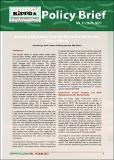Policy Brief No. 11 of 2020-2021 on Exploiting Job Creation Potential for Youth in the Tourism Sector in Kenya
View/
Publication Date
2020Author
Type
KIPPRA Publicationsviews
downloads
Metadata
Show full item recordBy
Munga, Boaz; Onsomu, Eldah;Nyabaro, Violet & Shibia, Adan
Abstract/
The tourism sector in Kenya offers three major product lines, namely: safari, coastal, and business and conference travel. The tourism sector contributes to socio-economic development through supply chain linkages with other sectors. The United Nation’s Department of Economic and Social Affairs identifies various activities linked to tourism, including accommodation for visitors; food and beverage serving activities; passenger transport (road, railway, water, air); transport equipment rental; travel reservation services activities; cultural activities; sports and recreational activities; retail trade; and other country-specific tourism characteristic activities. These activities confer Kenya with strengths that can be harnessed to promote further development of the sector and its performance. Besides job creation through supply chain linkages, tourism contributes to foreign exchange earnings, enterprise development, and investment across other sectors. Further, the sector provides incentives to preserve natural and cultural sites and improve local environmental management and sustainable development. The sector contributes about 10% of Kenya’s Gross Domestic Product (GDP), and it is a key source of employment growth and poverty alleviation
Publisher
Kenya Institute for Public Policy Research and AnalysisSeries
PB/11/2020-2021Collections
- Policy Briefs [165]

